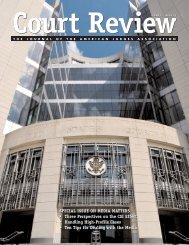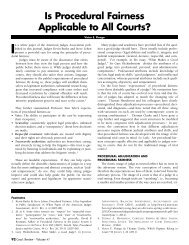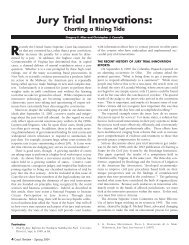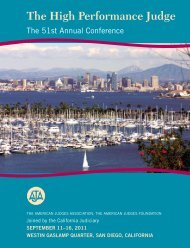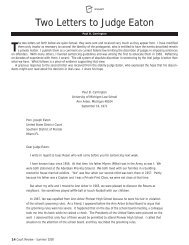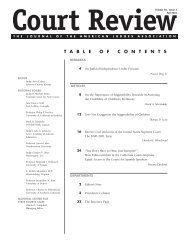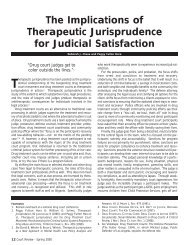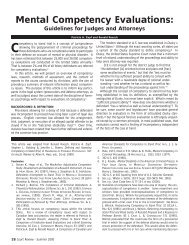Special Issue on Procedural Fairness - American Judges Association
Special Issue on Procedural Fairness - American Judges Association
Special Issue on Procedural Fairness - American Judges Association
- No tags were found...
You also want an ePaper? Increase the reach of your titles
YUMPU automatically turns print PDFs into web optimized ePapers that Google loves.
percepti<strong>on</strong>s of fairness—in procedures and outcomes—will ratetheir court experience more highly, even after c<strong>on</strong>trolling for avariety of factors. By c<strong>on</strong>trast, those with more negative percepti<strong>on</strong>sof fairness have an increased chance of rating theircourt experience less highly. Importantly, after tenants percepti<strong>on</strong>sof fairness are taken into account, tenants’ court locati<strong>on</strong>(i.e., Harlem vs. downtown) is no l<strong>on</strong>ger a statistically significantpredictor of satisfacti<strong>on</strong>. Thus, pro se tenants perceive thecourt experience in Harlem more positively because they are morelikely to perceive the court process and appearance outcome as fair.VII. CONCLUSIONSThis study was designed to determine how pro se tenantsperceived their court experiences in the community-basedHarlem Housing Court and the centralized housing courtslocated in southern Manhattan. The survey findings indicatethat, in most areas, Harlem tenants viewed their court experiencein somewhat more positive terms. Harlem tenants givethe court higher marks with regard to taking their legal rightsinto account, fairness both in court procedures and the outcomesof the court appearance, and overall satisfacti<strong>on</strong> withthe court experience.To be sure, both the downtown and Harlem housing courtsfare very well in terms of tenant percepti<strong>on</strong>s of the court experience.C<strong>on</strong>trary to some accounts, 11 our findings indicate generallypositive percepti<strong>on</strong>s even am<strong>on</strong>g tenants appearing inthe high-volume downtown housing court. Across nearly allmeasures, the community-based Harlem Housing Courtappears to achieve its goal of improving tenants’ comprehensi<strong>on</strong>of their court experience as well as their percepti<strong>on</strong> thatthey were treated fairly, both in terms of the court process andthe outcome of that process.Importantly, our analysis dem<strong>on</strong>strates that the more positivepercepti<strong>on</strong>s of the Harlem Housing Court experience aredue largely to the fact that Harlem tenants are more likely thanthose downtown to feel that the court process and outcomesare fair. While this finding is not surprising in so far as it isc<strong>on</strong>sistent with a broad literature emphasizing the importanceof perceived procedural justice, its implicati<strong>on</strong>s for housingcourt are potentially far-reaching. Enhanced percepti<strong>on</strong>s ofprocedural fairness are not necessarily inherent to a community-basedcourt model—indeed, the centralized downtownhousing courts also receive high marks <strong>on</strong> procedural justicemeasures. The findings suggest that steps can be taken to furtherimprove percepti<strong>on</strong>s of procedural fairness in all court settings.Educating judges and court staff about procedural fairness,and identifying and implementing best practices for promotingprocedural fairness, are two examples of such steps.The results do raise areas for potential follow-up by boththe Harlem and downtown housing courts. For example, courtobservati<strong>on</strong> indicates that the judges both in Harlem anddowntown ask if the tenant understands the proceedings andif the tenant agrees with the stipulati<strong>on</strong> (in cases where <strong>on</strong>eexisted) less than half of the time. These results suggest thatjudges in both sites could do more to verify and to improvetenant understanding of the court process.Certainly, there are limits to what this study can tell usabout the Harlem Community Justice Center. Most important,since we lack data about case outcomes and future tenantappearances in housing court, we cannot evaluate whether orto what extent the Harlem Community Justice Center hasachieved its goal of reaching speedier and more durable caseresoluti<strong>on</strong>s. Future research might address this issue.Note too that other potentially c<strong>on</strong>founding factors forwhich we lack data may also help to shape tenant percepti<strong>on</strong>s.For example, we do not know whether tenants are of the samerace or gender as the judge before whom they appeared. It ispossible that these or other factors may affect litigant percepti<strong>on</strong>sof the judge as well as their overall percepti<strong>on</strong> of howthey were treated by the court.Nevertheless, the survey results offer encouraging news asto the benefits of a community-based housing court. TheHarlem model does appear to enhance pro se litigants’ percepti<strong>on</strong>sof fair treatment and their overall satisfacti<strong>on</strong> with thecourt process. It is hoped that the results of our research willhelp court planners, both in New York City and nati<strong>on</strong>wide,when deciding whether to advocate for a greater number ofcommunity-based housing courts and/or to apply features ofthe Harlem Community Justice Center model <strong>on</strong> a broaderscale.Rashida Abuwala is a Research Associate at theHarlem Community Justice Center, an innovativecommunity court in the East Harlem neighborhoodof New York City that focuses <strong>on</strong> housing,pris<strong>on</strong>er reentry, youth programming andaddressing other community needs. She graduatedwith h<strong>on</strong>ors from Wesleyan Universityearning a BA in Government.D<strong>on</strong>ald J. Farole, Jr., Ph.D., is a PrincipalResearch Associate at the Center for CourtInnovati<strong>on</strong> in New York City. His currentresearch focuses <strong>on</strong> problem-solving courts andother innovative criminal and civil justice programs.Dr. Farole received a Ph.D. in PoliticalScience from Indiana University in 1996. Hecan be reached at DFAROLE@courts.state.ny.us.The authors would like to thank the H<strong>on</strong>orable Fern Fisher,Administrative Judge of the Civil Court of the City of New York,and all of New York City’s housing court judges, for their supportand cooperati<strong>on</strong> in helping to administer the survey up<strong>on</strong> whichthis research is based. We thank Greg Berman, Alfred Siegel, RayeBarbieri, Chris Watler, and Michael Rempel for feedback <strong>on</strong> earlierversi<strong>on</strong>s of this article. Any opini<strong>on</strong>s and interpretati<strong>on</strong>s arethose of the authors; they do not necessarily represent the officialpositi<strong>on</strong>s of the New York City Housing Court or the Center forCourt Innovati<strong>on</strong>/Harlem Community Justice Center.11. E.g., Golowitz, supra note 3.Court Review - Volume 44 61



